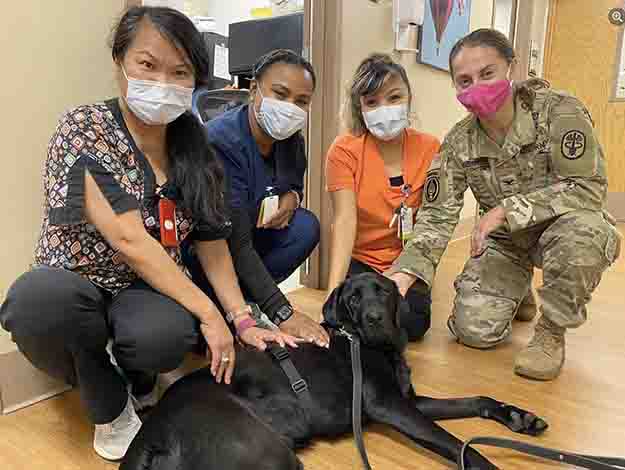Wounded warriors have driven facility dog evolution in the Military Health System. This reflects the respect these service members have for the dogs and their mission of providing comfort and support.
Amy O'Connor, facility dog program manager at Walter Reed National Military Medical Center, Bethesda, Maryland, recounted how one wounded warrior came to her and said, "Hey, I'd like you to make a uniform for Archie out of my pants." Archie, a retired German Shepherd then at WRNMMC, was an honorary Marine colonel and O'Connor's dog.
"It started a connection with these dogs that was different," she said. Most facility dogs now have a uniform for their service, and not only their tactical dress uniform, but also a service dress uniform, and special holiday and awareness clothes. Today, the materials for the uniforms come more from the dogs' handlers because we're in an interim period of conflict.
Most facility dogs' uniforms have flaps or pockets. Wounded warriors and staff often pin insignias, mission and rank patches, and other meaningful mementos inside the flaps.
U.S. Navy Capt. Julie Ann Darling's dog Angus, a black Labrador Retriever, is an honorary Navy Nurse Corps lieutenant. A flight nurse colleague of Darling's said she would like Angus to wear her flight wings. "That's kind of the tradition," Darling said.
These mementos can also bring closure to grieving service members' families, O'Connor suggested.
The family of a service member who died suddenly contacted O'Connor. The service member had given Archie his corpsman badge. "His parents reached out and asked if the new dog (at Walter Reed named Luke, a German Shepherd) could wear their son's badge, and of course we said yes. So, it's layered in history," she said. Luke is an honorary Hospital Corpsman 2nd Class.
"Some of the things that get passed down to us are really sad ... but we believe that by passing them from one dog to the next, we keep that person's memory alive," O'Connor said. "It's steeped in tradition and commitment to others."
Archie's uniform had so many devices attached that it weighed 10 pounds. His jacket, a painting, and his mementos are located at the National Museum of the Marine Corps in Quantico, Virginia.
Harvey Duze, a photographer at WRNMMC, has been involved with recording the roles of facility dogs since the center first used them in 2007.
"Not a day goes by that we don't see the dogs going through the hospital, and if you have the worst day in the world, when you see those dogs, it just makes you feel so much better," he said.
Wounded warriors at the hospital are away from home and may be pet owners, Duze said. When the facility dogs visit these patients, "it's like a little slice of home for them. It's really great to see the interaction. It takes their mind away from some of the craziness they've been through."
Psychological, physical, emotional benefits of facility dogs
"The physical, psychological, and emotional health benefits associated with the human-animal bond have truly emerged in the scientific literature over the past few decades as the research community seeks to quantify why we are so drawn to companion animals," said U.S. Army Lt. Col. Todd French, the Army Veterinary Corps Department of Defense advisor on the human-animal bond and deputy commander of the Fort Cavazos Public Health Activity Hood in Fort Hood, Texas.
"These studies have not only confirmed previous findings related to the NIH.gov" href="https://pubmed.ncbi.nlm.nih.gov/37422586/" target="_blank">cardiovascular benefits of the bond, like decrease in heart rate and blood pressure associated with pet contact, but also revealed that animals positively influence hormones related to well-being like beta-endorphins, dopamine, and oxytocin," French explained.
"Several studies show that animal contact is also associated with psychological and emotional health benefits like decreased stress (through reduction in the hormone cortisol), alleviation of depression, and the treatment of PTSD."
Animals also get benefits from human interaction. "Research shows that social interactions with humans can decrease cortisol levels and increase oxytocin in our four-legged buddies," French added.
Facility dogs across the MHS
Facility dogs are provided to MHS handlers after significant temperament training through nonprofit service dog training organizations. They are matched with a facility handler who takes responsibility for their well-being and duties. A sampling of facility dogs includes:
- Madigan Army Center's Capt. Earl, a black Lab.
- U.S. Army Maj. Budd, a yellow Lab who was honorarily commissioned on June 6, 2022, as one of Brooke Army Medical Center's two facility dogs, along with U.S. Air Force Maj. McAfee.
- U.S. Navy Lt. Cmdr. Ellie Mae at WRNMMC, who specializes in reducing stress associated with dental procedures.
- U.S. Air Force Maj. Gen. Goldieat WRNMCC, who's an honorary Airforce.com" href="https://www.airforce.com/thunderbirds/overview" target="_blank">Thunderbird.
- Cpt. Patty Mac, Cpt. Charlie, and Cpt. Izzy, at Naval Medical Center Portsmouth, who are three of approximately 10 therapy facility dogs serving in the Navy.
- U.S. Navy Lt. Cmdr. Shetland and U.S. Army Sgt. Grover at the Uniformed Services University's F. Edward Hébert School of Medicine.
- U.S. Marine Corps Master Sgt. Dillon, a black Lab at WRNMMC.
- Lt. LC, at Naval Medical Center San Diego, a yellow Lab who works with Hospital Corpsman 2nd Class Cork, a black Lab.





Read Comments